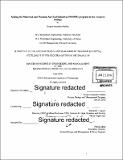| dc.contributor.advisor | Richard C. Larson. | en_US |
| dc.contributor.author | Fernandes Prabhu, Deepa | en_US |
| dc.contributor.other | Massachusetts Institute of Technology. Engineering Systems Division. | en_US |
| dc.date.accessioned | 2017-01-06T16:13:38Z | |
| dc.date.available | 2017-01-06T16:13:38Z | |
| dc.date.copyright | 2016 | en_US |
| dc.date.issued | 2016 | en_US |
| dc.identifier.uri | http://hdl.handle.net/1721.1/106245 | |
| dc.description | Thesis: S.M. in Engineering and Management, Massachusetts Institute of Technology, School of Engineering, System Design and Management Program, Engineering and Management Program, 2016. | en_US |
| dc.description | Cataloged from PDF version of thesis. | en_US |
| dc.description | Includes bibliographical references (pages 102-105). | en_US |
| dc.description.abstract | The Maternal Mortality Ratio (MMR) and Infant Mortality Rate (IMR) are very high in parts of rural India when compared to other developing and developed countries. To address these high rates the World Health Organization (WHO) set up Millennium Development Goals (MDG) for each country to reach by 2015. These goals prompted many national and international organizations to focus on programs to reduce IMR and MMR in the recent years. The Maternal and Newborn Survival Initiative (MANSI) is a successful field-tested approach for addressing widespread and persistent problems with high MMR and IMR. Implemented in the Seraikela area of Jharkhand state in India, it has achieved a 32.7% reduction in neonatal mortality, 26.5% reduction in IMR and 50% increase in hospital births. The MANSI program was implemented in 2009 by a public and private partnership (PPP) between American India Foundation (AIF), Tata Steel Rural Development Society (TSRDS), Society for Education, Action and Research in Community Health (SEARCH) and the Government's Department of Health & Family Welfare in the Seraikela area 38 km from the headquarters of Tata Steel. If this program could be replicated or scaled in other similar resource-constrained areas, the MMR and IMR in those areas could be reduced as well. However, the MANSI program was developed with a unique PPP pilot program in an area where TSRDS has other programs to improve the quality of life of the residents and thereby enjoys the community's trust and support. This thesis investigates whether this program can be replicated or scaled elsewhere, within or outside the TSRDS area of influence, where it is desperately needed as either the same pilot program implemented in Seraikela or a modified one. Analysis of the MANSI system and process demonstrates that this program can be scaled or replicated if the implementers choose partners with similar goals, follow the MANSI system architecture, adapt the system design to local traditional practices and establish trust and accountability with the local citizens. Further, maternal and child health policy implementations by the local government will facilitate the improvement of IMR and MMR. | en_US |
| dc.description.statementofresponsibility | by Deepa Fernandes Prabhu. | en_US |
| dc.format.extent | 105 pages | en_US |
| dc.language.iso | eng | en_US |
| dc.publisher | Massachusetts Institute of Technology | en_US |
| dc.rights | M.I.T. theses are protected by copyright. They may be viewed from this source for any purpose, but reproduction or distribution in any format is prohibited without written permission. See provided URL for inquiries about permission. | en_US |
| dc.rights.uri | http://dspace.mit.edu/handle/1721.1/7582 | en_US |
| dc.subject | Engineering and Management Program. | en_US |
| dc.subject | System Design and Management Program. | en_US |
| dc.subject | Engineering Systems Division. | en_US |
| dc.title | Scaling the Maternal and Neonatal Survival Initiatives (MANSI) program in low resource settings | en_US |
| dc.type | Thesis | en_US |
| dc.description.degree | S.M. in Engineering and Management | en_US |
| dc.contributor.department | Massachusetts Institute of Technology. Engineering and Management Program | en_US |
| dc.contributor.department | System Design and Management Program. | en_US |
| dc.identifier.oclc | 961922086 | en_US |
